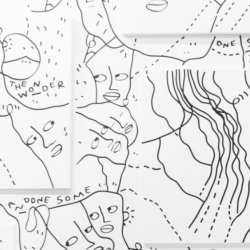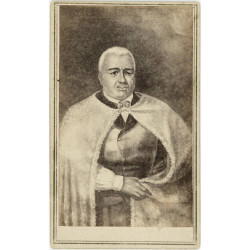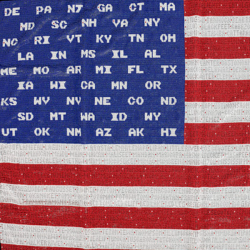Tess Porter
User Experience Strategist (she/her)
Smithsonian Office of Educational Technology
I'm the former User Experience Strategist at the Smithsonian Office of Educational Technology. Here, I focused on the use of digital museum resources to support teaching and learning. My work draws on my experience as a museum educator, digital analyst, usability researcher, and content designer. I hold a B.A. in Anthropology and a B.A. in Art History from University Colorado Boulder, and an M.S. in Museums and Digital Culture with an Advanced Certificate in User Experience from Pratt Institute.
Tess Porter's collections
Edgar Allan Poe: Examining Portraiture
<p>This teacher's guide provides portraits and analysis questions to enrich students' examination of Edgar Allan Poe, an American poet and author known for his stories of mystery, horror, and the macabre. Includes the video "Defining Portraiture: How are portraits both fact and fiction?" and the National Portrait Gallery's "<em>Reading" Portraiture Guide for Educators, </em>both of which provide suggestions and questions for analyzing portraiture. </p>
<p>Consider:</p>
<ul><li>What do these portraits have in common? How are they different?</li><li>How are these portraits both fact and fiction?</li><li>How do these portraits reflect how Edgar Allan Poe wanted to be seen, or how others wanted him to be seen? Consider for what purpose these portraits were created (such as the photograph, the stamp, the painting, etc.).</li><li>Having read one of his works, does the portrait capture your image of Edgar Allan Poe? Why, or why not?</li><li>If you were creating your own portrait of Edgar Allan Poe, what characteristics would you emphasize, and why?</li></ul><p>Keywords: boston, massachusetts, ma, baltimore, maryland, md, allen, gothic, raven, tell tale heart</p>
 Tess Porter
Tess Porter
7
Esperanza Spalding: Examining Portraiture
<p>This teacher's guide provides portraits and analysis questions to enrich students' examination of Esperanza Spalding, a Grammy-winning jazz bassist and singer. Includes the video "Defining Portraiture: How are portraits both fact and fiction?" and the National Portrait Gallery's "<em>Reading" Portraiture Guide for Educators, </em>both of which provide suggestions and questions for analyzing portraiture. Also includes a video of artist Bo Gehring speaking about his portrait of Spalding and a Smithsonian Magazine article about her curation of an exhibit at the Cooper Hewitt, Smithsonian Design Museum.</p>
<p>Consider:</p>
<ul><li>What do these portraits have in common? How are they different?</li><li>How are these portraits both fact and fiction?</li><li>How do these portraits reflect how she wanted to be seen, or how others wanted her to be seen? Consider for what purpose these portraits were created.</li><li>Having read listened to her music, does the portrait capture your image of Esperanza Spalding? Why, or why not?</li><li>If you were creating your own portrait of Esperanza Spalding, what characteristics would you emphasize, and why?</li></ul><p>Keywords: musician, oregon, American, #BecauseOfHerStory, #SmithsonianMusic</p>
 Tess Porter
Tess Porter
7
Eudora Welty: Examining Portraiture
<p>This teacher's guide provides a portrait and analysis questions to enrich students' examination of Eudora Welty, a Pulitzer Prize-winning author known for her evocative novels and short stories set in the American South. Includes the video "Defining Portraiture: How are portraits both fact and fiction?" and the National Portrait Gallery's "<em>Reading" Portraiture Guide for Educators, </em>both of which provide suggestions and questions for analyzing portraiture. Also includes a video and blog post that look closely at this portrait, as well as a related article about Mississippi's new writers trail that may be used as a lesson extension.</p>
<p>Consider:</p>
<ul><li>How is this portrait both fact and fiction?</li><li>How does this portrait reflect how Eudora Welty wanted to be seen, or how others wanted her to be seen? Consider for what purpose this portrait was created.</li><li>Having read one of her stories, does the portrait capture your image of Eudora Welty? Why, or why not?</li><li>If you were creating your own portrait of Eudora Welty, what characteristics would you emphasize, and why?<em></em></li></ul><p>Keywords: mississippi, ms, story, optimist's daughter, writer, #BecauseOfHerStory</p>
 Tess Porter
Tess Porter
6
Flashcard Activity: Asian Pacific American Resources
<p>This collection contains a diverse set of resources related to Asian Pacific Americans that may be used as an introductory activity to spark classroom discussion and prompt students to conduct research about how Asian Pacific American history is American history. For discussion questions and activity implementation ideas, click "Read More." A file to print these resources as flashcards is located at the end of the collection; please see the resource's Information (i) tab for printing instructions.</p>
<p>This collection is not comprehensive but rather provides a launching point for further research and study.</p>
<p><em>This Smithsonian Learning Lab collection received Federal support from the Asian Pacific American Initiatives Pool, administered by the Smithsonian Asian Pacific American Center. </em></p>
<p>Keywords: printable, flash card, think puzzle explore, project zero visible thinking routine, apa</p>
<p>#APA2018</p>
 Tess Porter
Tess Porter
48
Flashcard Activity: Civic Discourse
<p>This collection contains a diverse set of resources related to civic discourse that may be used as an introductory activity to spark classroom discussion and prompt students to conduct research. For discussion questions and activity implementation ideas, click "Read More." <br></p>
<p>This collection is not comprehensive but rather provides a launching point for further research and study.</p>
<p><em>This Smithsonian Learning Lab collection received support from The Grable Foundation.</em></p>
<p>Keywords: flash card, think puzzle explore, project zero visible thinking routine, social justice, equity, civil rights, protest, activism, culture, cultural identity, representation, sensitivity, community, communities, politics, immigration, migration</p>
<p>#civicdiscourse</p>
 Tess Porter
Tess Porter
68
Flashcard Activity: Conflict, Identity, and Place in American Art
<p>This collection contains a selection of artworks related to the themes of conflict, identity, and place. They may be used for a variety of purposes; here, we use them as a catalyst for discussion. In small groups or as a classroom, have students select one artwork they find meaningful or interesting and discuss the following:</p>
<ol><li>Why did you pick this artwork? </li><li>What do you see? Name specific aspects of the artwork you notice.</li><li>What do you think about what you see?</li><li>What does this artwork make you wonder? </li><li><em>Optional</em>: How might the artwork connect to the themes of conflict, identity, and place?</li></ol>
<p>
</p>
<p>This activity works equally well online or using printed flashcards (see <a href="https://learninglab.si.edu/collections/flashcard-activity-conflict-identity-and-place-in-american-art/wCjeBXbgRgExR2Py#r/883001">the resource tile</a>). You may also replace or pair the above activity with a Project Zero Thinking Routine found in the final section of the collection. </p>
<p><em>This Smithsonian Learning Lab collection contains artwork selected by <a href="https://learninglab.si.edu/profile/666">Phoebe Hillemann</a>, Teacher Institutes Educator at the Smithsonian American Art Museum, to be featured in the 2018 Smithsonian American Art Museum Summer Institute for Teachers, "Teaching the Humanities through Art." The activity is adapted from Project Zero's See / Think / Wonder routine.</em></p>
<p>Keywords: printable, flash card, project zero visible thinking routine, New Jersey Principals and Supervisors Association, NJPSA, saam</p>
 Tess Porter
Tess Porter
51
Homo floresiensis: Teaching Resources
<p>This topical collection gathers resources related to Homo floresiensis, commonly known as the Flores “Hobbit." H. floresiensis, was discovered in 2003, making it the second most recently discovered early human species. Contains a video, websites, a 3D interactive tour, and articles.</p><p>Keywords: physical anthropology</p>
 Tess Porter
Tess Porter
7
How Are Robots Changing Human Life?
<p>This collection explores the essential question: How are robots changing human life? Students will lead an inquiry into this question through a variety of resources - objects, videos, articles, and websites - examining the history of robotics from the 16th century to the present, the problems robot designers have attempted to address with their inventions, and how they try to address them. Supporting questions to scaffold students' inquiry include: What problems were these robots designed to address? Have these problems changed over time? Have strategies for addressing these problems changed over time?</p>
 Tess Porter
Tess Porter
22
Identity, Community, and Fire Hats
<p>What can objects reveal about the values and beliefs of the people who created them? Explore fire hats, worn by volunteer fire fighters on the East Coast during the 1800s. Created for use during both fires and parades, these ornate hats contain symbols – historical figures, allegorical images, patriotic scenes, and more – that proclaim the wearers' cultural and political identity, as well as their positions on religion and immigration. What symbols do you see?</p>
<p>This collection contains a small selection of fire hats from the Smithsonian. To continue exploring, <a href="https://learninglab.si.edu/search/?f%5B_types%5D%5B%5D=resource&st=fire%20hats&providers%5B%5D=National%20Museum%20of%20American%20History&s=&page=1">search for fire hats in the Smithsonian Learning Lab</a>. </p>
 Tess Porter
Tess Porter
12
Investigating Civil War Uniforms
<p>This topical collection includes resources related to Civil War uniforms. Investigating these Union and Confederate uniforms - through types, differences, and similarities - helps to understand the different human resources of the Union and Confederacy, as well as the experience of individuals who fought in the Civil War. </p>
<p>Collection contains two lesson plans (both of which can be adapted using resources in this collection), articles of clothing worn by Union and Confederate soldiers, lithographs, photographs, articles, a website, and a symposium.</p>
<p>Keyword: Zouave</p>
 Tess Porter
Tess Porter
58
Investigating Tribal Sovereignty through Objects
<p>This collection was created to accompany the live session <em>Cultivating Learning: Investigating Tribal Sovereignty through Objects,</em> hosted with guest educator Renée Gokey from the <a href="https://americanindian.si.edu/" target="_blank">National Museum of the American Indian</a>, which focuses on transferrable, inquiry-based techniques to help students explore and understand tribal sovereignty through cultural objects. Tribal sovereignty is the authority of Native nations to self-govern, and it impacts how Native nations operate their own governmental systems, manage tribal lands, build economic strength, and facilitate complex relationships with local, state, and federal governments. This collection includes digital museum resources and standards-based approaches discussed during the session. </p>
<p>This session aired live on June 13, 2022 at 4:00 PM ET; <a href="https://www.youtube.com/watch?v=IX7k1_pWa00" target="_blank">click here to view on YouTube</a>. </p>
 Tess Porter
Tess Porter
30
Japanese American Incarceration: Articles and Videos about Inmate Experiences
<p>This topical collection includes articles and videos about Japanese American experiences in incarceration camps. The collection highlights four individuals and their stories: Fred Korematsu, a civil rights activist; Minoru Yasui, a lawyer and civil rights advocate; Norman Mineta, a politician who grew up in the camps; and Isamu Noguchi, an artist who self-deported himself to an incarceration camp. Other important articles and videos about inmate experiences are located at the end. This collection is one in a series of collections, each containing different types of resources, about the Japanese American Incarceration; see also <a href="http://learninglab.si.edu/q/ll-c/gCGyk6eEyx7hGU4a">Japanese American Incarceration: Images of Camp Life</a>, <a href="http://learninglab.si.edu/q/ll-c/yqzp7FXFJtCqPsik">Japanese Incarceration: Publications, Letters, and Other Documents</a>, and <a href="http://learninglab.si.edu/q/ll-c/D1atcYAXArxq55uY">Japanese American Incarceration: Camp Objects</a>.</p>
<p>In February 1942, following the bombing of Pearl Harbor, President Roosevelt signed Executive Order 9066 and authorized the imprisonment of approximately 75,000 Americans of Japanese ancestry and 45,000 Japanese nationals in incarceration camps. This order was not rescinded until 1945.
</p>
<p>Teachers and students may use this collection as a springboard for classroom discussion. This collection is not comprehensive but rather provides a launching point for research and study.
</p>
<p><em>This Smithsonian Learning Lab collection received Federal support from the Asian Pacific American Initiatives Pool, administered by the Smithsonian Asian Pacific American Center.</em>
</p>
<p>Keywords: internment camp, world war ii, ww2, wwii</p>
<p>#APA2018
</p>
 Tess Porter
Tess Porter
30







